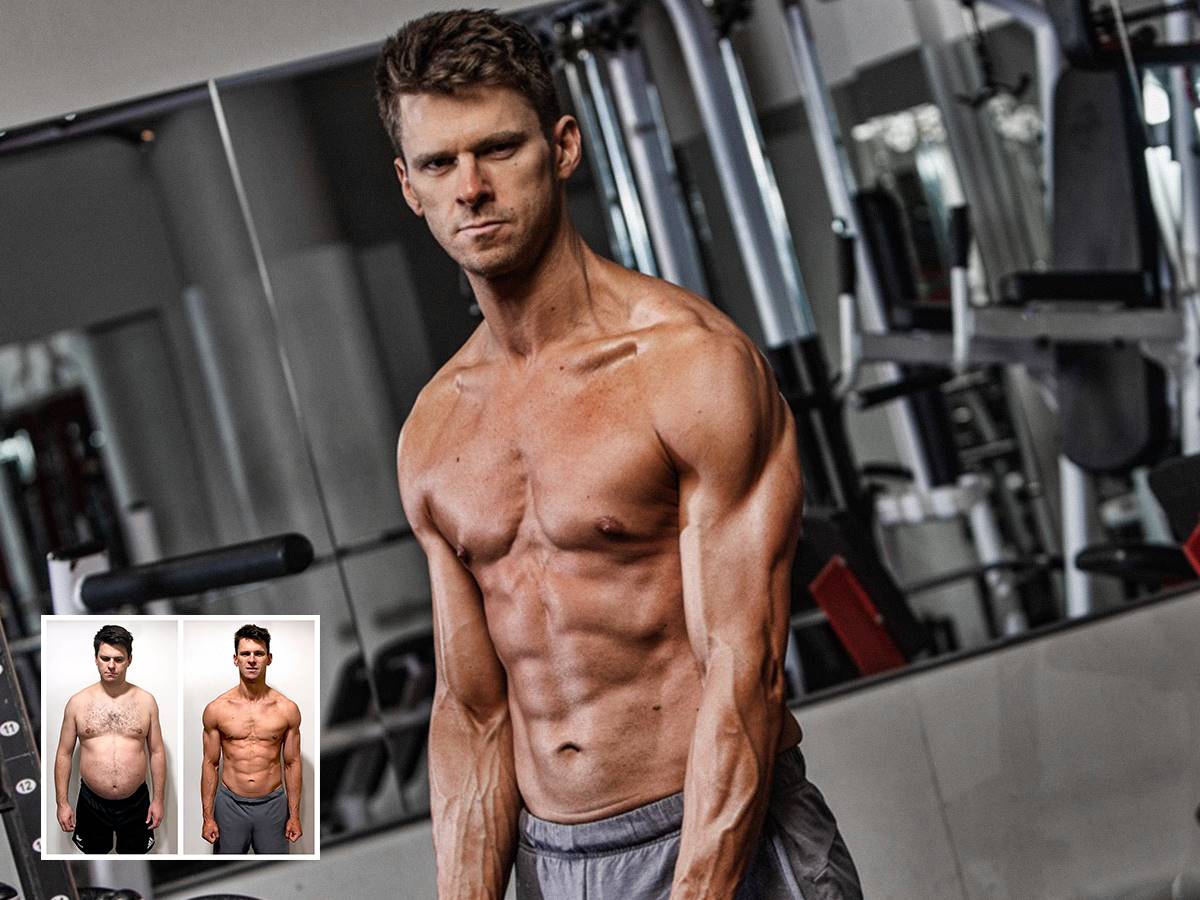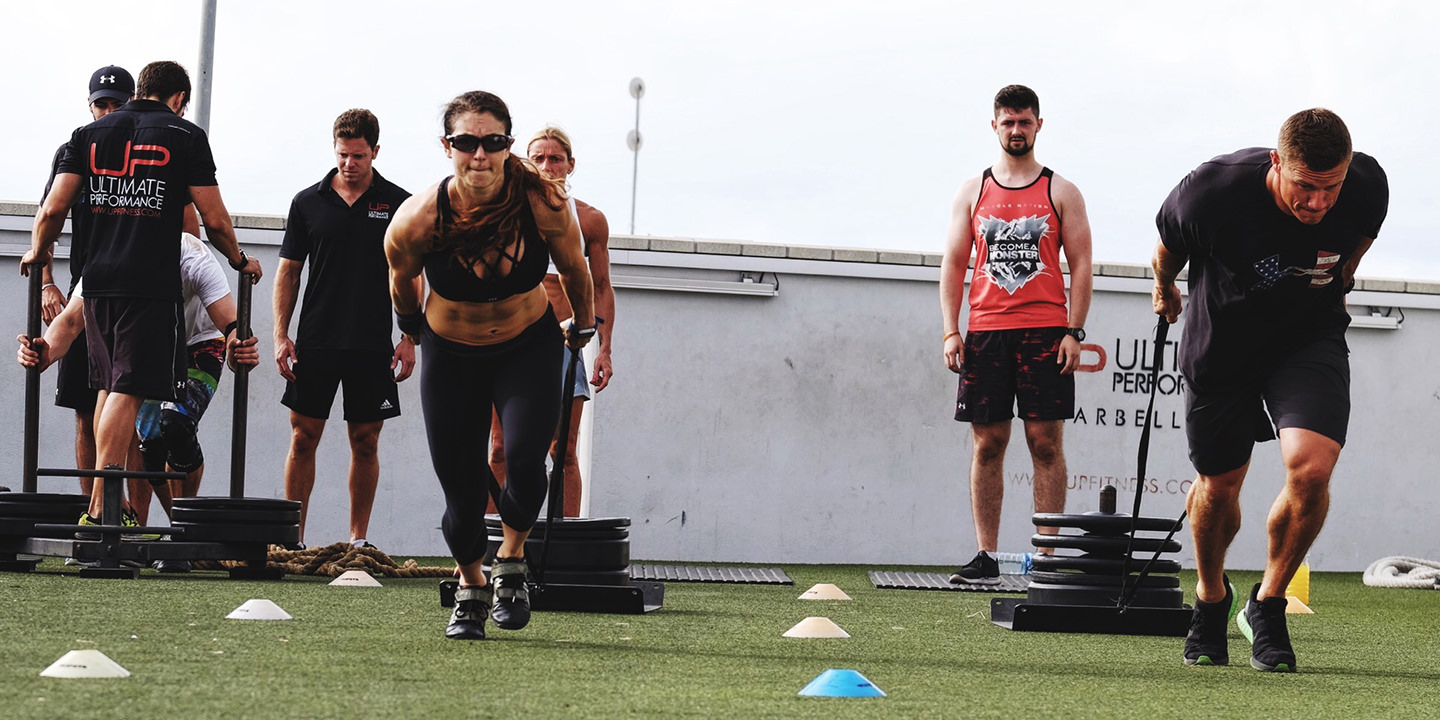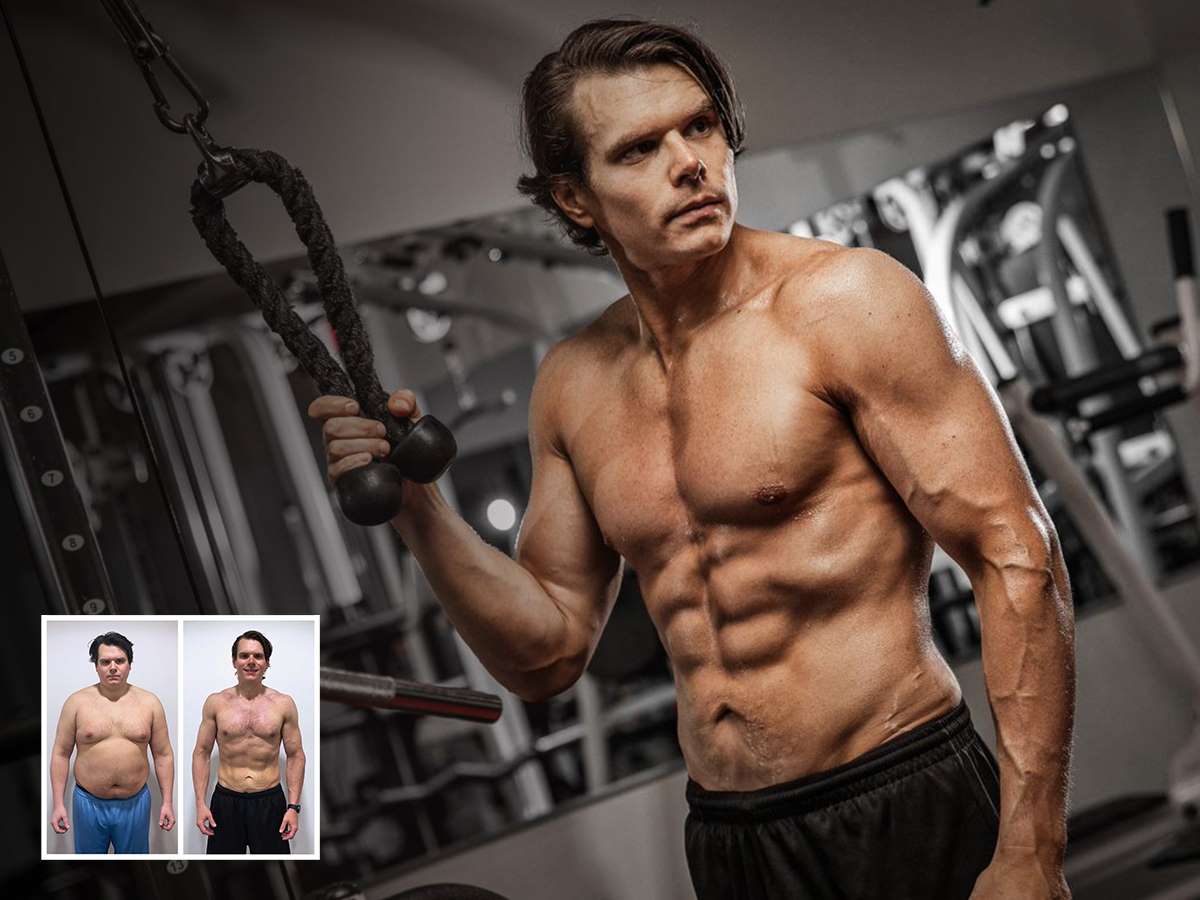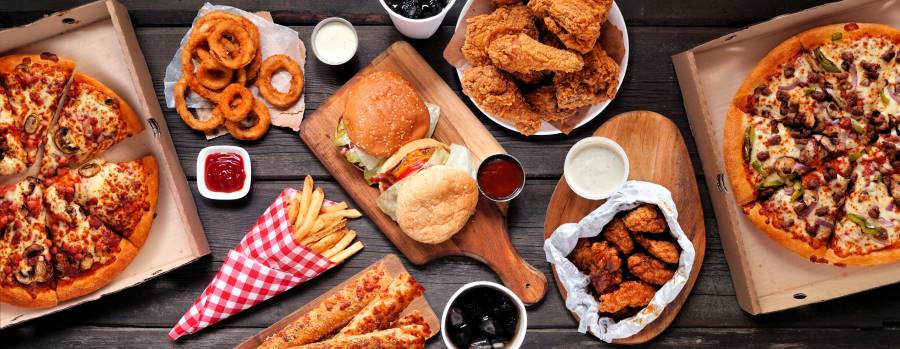Losing fat and building muscle at the same time – this is the ‘holy grail’ of fitness.
It’s known as ‘body recomposition’. But is it even possible to decrease your body fat levels while maintaining or even increasing your lean body mass?
If you are hammering strength workouts like the Rock and gulping down cold chicken breasts but still not seeing your body change, this goal probably feels a million miles away.
Yet, take one look at the results we help thousands of clients achieve at Ultimate Performance and you can see that ‘body recomp’ is actually achievable for most people, but…
There are seven mistakes you are probably making with your training, diet and lifestyle.
We’re going to show you exactly how to fix them. So you can start getting body recomposition results like the 25,000+ clients worldwide we have helped achieve incredible transformations.
It’s starts with understanding three simple things central to our methods…

Dan 35kg weight loss helps him be a fitter dad and sharper at work.
What is body recomposition, and is it possible?
You’ve seen the before and afters at Ultimate Performance. Average Joe goes from skinny fat to cover-model physique in just 12 weeks.
Surely that’s not possible?
Let us explain exactly how and why you can achieve results like this in minimum time.
To ‘recompose’ the body, or in more scientific terms, to achieve body recomposition, is to simultaneously build muscle mass and lose fat. The aim is to increase fat-free mass, essentially everything but fat.
This concept is often met with scepticism, with some people claiming that building muscle and losing fat simultaneously is implausible.
However, this process is entirely possible, dependent on a few key factors.
1. Being a ‘newbie’ or out of practice
Your mate Dave has been going to the gym for precisely three weeks, and his shoulders are beginning to resemble footballs.
What’s going on here?
Herein lies the phenomenon of ‘newbie gains’.
Individuals who have limited resistance training experience are able to build muscle at a much faster rate than those who have been training for longer.
When you have very little training experience, your muscles are hyperresponsive to the stimulus provided by resistance training. Studies even show you can gain as much as seven pounds in just the first three months of liftingi.
Even more interesting is that relatively untrained individuals can gain substantial amounts of muscle while also shedding body fat, therefore achieving recomposition.
Your average ‘meathead’ will tell you that you need to eat 10 times your body weight just to put on a scrap of muscle. But with individuals in their first one to two years of lifting, it is possible to add slabs to your frame without the hefty food bill.
So is body recomposition only possible for newbies?
Not necessarily…

2. Increasing your training intensity
If you have the energy to slide into somebody’s DMs during a set on the leg press, you are definitely not training hard enough.
Training intensity plays a massive role in the quality of your results. Research shows that you can dramatically improve your body composition by making very small changes to your program, even if you have been training for many years.
In one study, well-trained individuals only slightly increased their pre-existing leg training volume for eight weeks yet gained muscle massii.
But be aware that the speed of your gains will diminish over time – three to six pounds per year is good going if your recovery, nutrition and training are completely on-pointiii.
And if you needed a bigger reason to abandon the memes, your smartphone could also be killing your gains.
Early research has shown that smartphone usage before a lifting session may increase mental fatigue and decrease perceived physical strength.
And the results show that these effects can occur with as little as 30 minutes of exposure before working outiv.
Ditching the daily scroll could do you double the favour.
But all of this means nothing, if your diet isn’t on point either. Let us explain….

3. Dieting smart
It’s a well-known fact that if you want to gain as much muscle as humanly possible, everything you eat must be either beige or green.
Of course, we’re joking.
But so many people make the mistake of trying to eat like a bodybuilder and end up massively overly restricting their calories.
A calorie deficit is the prerequisite for fat loss. But we hear all too often from guys who struggle to achieve a result yet fail to do so long enough to reveal the muscle underneath.
At the other end of the scale, very aggressive diets yield very little when it comes to muscle growth.
We’re not likely to say don’t go hard on your diet. But there’s a balance.
An aggressive diet can improve your insulin sensitivity, so you will make better use of foods when you increase your calories post-transformationv. Hopefully, this means more calories helping to build muscle rather than being stored as fat.
A more aggressive approach also minimises how long you spend in a deficit, which is better for your long-term gains. Going too hard for too long can impair exercise performance and muscle growth.
One study split participants into two groups and monitored them over nine weeks. The first group maintained a moderate 500-calorie deficit while the other group maintained an 800-calorie deficit.
The results showed that both groups lost fat. Yet those in the moderate group also gained fat-free mass, whereas those following the more aggressive approach did not see any increasesvi.
Body recomposition is clearly possible. So why is it still not happening for you?
The answer could be more straightforward than you think…

Dan’s 40kg weight loss helps him beat high blood pressure and get abs.
Are you making one of these 7 mistakes?
We get it. You’re all revved up ready to start chipping away at that six-pack for your big summer getaway.
But getting there seems so damn complicated!
Unfortunately, the wealth of conflicting information online can lead to ‘paralysis by analysis’. There is no silver bullet, but if you’re struggling to see results, here’s where you could be going wrong.
1. You’re not in a calorie deficit
Nutrition plays a huge role in body composition. Unfortunately, training hard doesn’t write off eating a whole tub of Ben & Jerry’s every night.
You guessed it, you gotta diet.
And how you do this will make a big difference to your results.
A moderate deficit strikes a balance between good progress and effective recovery, with a cover-model look to boot. For most guys, that’s somewhere in the region of 0.7-1.5% total body weight loss per week.
And keeping that all-precious muscle won’t just make you look better on the beach.
More lean body mass means you burn more calories at rest. You can then maintain your new physique eating higher calories, meaning better performance and increased gains.

2. Your food choices are not up to scratch
Quality over quantity, every time.
Despite what the IIFYM zealots might tell you, food quality does matter.
Now that’s not to say there is no room for higher-calorie foods on occasion.
Yet the research consistently shows that high-quality, unprocessed foods score far higher when it comes to hunger management, effective recovery and balancing other hormones responsible for regulating metabolismvii.
Make your calories go further with high-quality proteins (lean, unprocessed animal sources wherever possible), healthy fats (nuts, seeds, avocado, olive oils, oily fish) and a tonne of leafy green veggies.
And it’s not just food quality that is important. Their macronutrient content is also critical.
You don’t have to chug down a protein shake immediately post-workout for fear of losing your gains. But your protein intake has a major impact on how much muscle you retainviii.
Between 2.2-2.8 grams of protein per kilo of lean body mass per day, split up every three to four hours, is the sweet spot for most traineesix.

3. You’re not moving enough
Decreasing your food intake is only one piece of the puzzle when it comes to creating a deficit.
In fact, most research shows that cutting down food alone is pretty ineffective if you want to really change your bodyx.
However, if you combine decreased food intake with increased activity, you have a powerful recipe for fat loss.
Increasing how much you move day-to-day will speed up progress without wrecking your gym performance. Anywhere upwards of 10,000 steps is a great place to start.

4. You’re not following a progressive training program
It doesn’t matter how many bicep curls you can do in a minute or that you’re using an Olympic barbell in the squat rack. If you’re lifting the same weight you did five years ago, it’s no wonder your results are lacklustre.
Progressive overload is the cornerstone of muscle growth and tracking your total training volume (sets x reps x load) over time is critical.
Likewise, destroying yourself with insane amounts of volume may look impressive, but your inability to walk the next day isn’t great for hypertrophy either.
Track your workouts and track your training intensity. For most people, this looks like one to two reps shy of failure on your initial working sets and push for all-out failure on the final setxi.
And fellas, ditch the body part splits.
Training each body part only once per week might give you a great pump, but it’s not ideal if growth is your goal.
It is your total training volume and proximity to subjective failure that are the biggest determinants of muscle gainxii,xiii.
So, instead of heading to ‘international chest day’, spread those chest exercises across multiple days. Splitting up your exercises so that you hit each body part two to three times per week allows you to maximise training volume and intensity.

Ahmad builds his ‘perfect body’ in 90 days to overcome his pandemic rut.
5. You’re not tracking your progress
At Ultimate Performance, we’re big on tracking progress.
What gets tracked gets measured, and if you don’t, how do you know if the plan is working?
Pictures can take six to eight weeks to show change, so if you’re anticipating a visible difference after two weeks of dieting, expect to be disappointed.
And while fat loss, not weight loss, is the main goal, scale weight is an incredibly useful metric.
Muscle gain and fat loss occur at very different rates. To gain muscle at exactly the same rate as fat loss, let’s just say you’d be verging on Arnie-level genetic potential.
So, don’t be fooled; the scale needs to start moving to start chiselling away to see that hard-earned muscle.
Tracking your weight, steps, food intake and training provide critical data that indicate if you are progressing or if you need to make a change. 5.

6. Your sleep sucks
If your bedtime routine involves getting into bed at midnight for an hour of Netflix, that’s not the eight hours of quality sleep you think you’re getting!
Poor sleep can have a seriously negative impact on your body recomposition efforts.
Sleep loss can increase cravings for sugary foods, reduce your motivation to train, and lead to a higher proportion of weight lost from muscle mass when in a calorie deficit.
In one study, participants were subjected to 14 days of moderate caloric restriction with either 8.5 hours or 5.5 hours’ sleep. Although both groups lost fat, the group who only had 5.5 hours of sleep saw the proportion of weight lost as fat decrease by 55%, and their fat-free mass dropped by 60%xiv. Those who had less sleep also reported greater feelings of hunger.
Improving your sleep hygiene will provide an instant, cost-free improvement on your gym gains.

7. You’re stressed out
Stress is an unavoidable fixture of modern life. Not all stress is bad but ‘chronic’ stress is a killer for your gains and your health.
Consistently elevated cortisol levels are associated with muscle weakness and reduced capacity to draw amino acids into muscle cellsxv.
In simple terms, stress blocks your body’s ability to utilise the building blocks it needs to repair and grow muscle tissue.
Stress management, be it meditation, exercise, journaling or even a new hobby, is one of the most underrated tricks to building a cover-model physique.

The-take home
You heard it… body recomposition is real!
And you don’t need an all-singing, all-dancing complicated plan to get there either.
Progressing your training, maximising your food quality, and prioritising effective recovery…
Nail these basics consistently and it’s more than possible to boost your size while sculpting a lean, muscular physique.
If you need help taking your results to the next level, contact Ultimate Performance today.
FAQ’s
Is there a specific workout for body recomposition?
There is no specific workout you need to do for body recomposition.
Body recomposition refers to decreasing your stored body fat while maintaining or increasing your level of lean body mass, primarily through muscle. For nearly everyone, this involves weight loss, which means you need to burn more calories than you take in through food. But if we want to ensure that we lose fat and not just overall weight. We need to do two things.
The first is to consume enough high-quality protein that gives the body a reason to tap into muscle and not body fat. The second is to provide the body with a stimulus to maintain and grow new muscle; namely resistance training.
Now, there is no specific ‘workout’ that will allow us to achieve this but some training approaches may allow us to do this better than others. For example, very low rep, heavy resistance training may be sufficient stimulus for an advanced trainee to acquire the amount of ‘training volume’ they need to maintain muscle – as long as they are training close to muscular failure and increasing how much they lift over time.
But a completely new lifter has not yet had a chance to develop the neurological adaptations required to lift very heavy loads safely, neither does low-rep training provide the practice to do so.
At the other end of the scale, very high rep training means you spend a lot of time performing a movement without those reps being ‘effective’. This means that it takes a lot of repetitions before it becomes challenging to the muscle, making it less time efficient.
For the majority of our clients, hypertrophy-style training that uses moderate loads at moderate rep ranges tends to provide enough practice in movements to get strong, while creating the stimulus the body needs to hang onto muscle.
But how that looks precisely, the exercises you perform, the rep ranges you work in or the precise training split you follow may vary significantly depending on your experience and abilities, preferences, and unique anatomical structure.
How long does body recomposition take?
Body recomposition effectively means decreasing your stored body fat levels while maintaining or increasing your level of lean body mass, primarily through muscle.
For nearly everyone, this involves weight loss, which requires consuming fewer calories than you burn.
And by combining this calorie deficit with a high-protein diet and resistance training, you can encourage the body to tap into its stored energy, i.e. body fat, and not hard-earned, metabolically healthy muscle tissue.
How long it takes to achieve a low level of body fat from your current starting point depends on a multitude of factors, such as your genetics, training experience, current body fat levels, your lifestyle, how hard you are willing or able to diet, and more.
We can never know exactly how fast fat loss is occurring or precisely the proportion of weight that is lost as fat or muscle without testing, such as calliper measurements or DEXA scan. And even these assessment methods come with a margin of error.
But we know that the sweet spot for most people is losing between 0.5% to 1.5% of their total body weight per week. This strikes the right balance between effective progress while minimising the risk of muscle loss during the diet.
The amount of muscle you may gain during this ‘recomposition’ period depends on your exercise history and how long you have been training.
If you have been away from exercising for a while or you are a complete beginner, you’ll likely benefit from ‘newbie gains’. This just means that for around 20% effort, you’ll get around 80% reward. But the longer you train, the more effort you have to put in for the same results – think 80% effort for 20% gain. So, the more experienced you are, the less muscle you are likely to build during a recomposition phase.
But we can say is that most of our clients will lose somewhere in the region of 10-12% of their total body weight over a 12-week period if they achieve their weekly targets. However, this varies depending on your starting weight, body composition and how much time you have available to exercise.
How many calories do I need for body recomposition?
This question really could be asking “how long is a piece of string?”!
Everyone is unique so the precise number of calories you need to eat to create the calorie deficit you need for fat loss is highly variable.
It is also a moving target, as you may be very active on one day but may not get out of bed on another if you are not controlling for consistency, i.e. meeting a daily activity target. Clearly, how much energy you burn in these two scenarios will be very different.
This ‘magic number’ depends on your unique genetic make-up, your current body composition, how active you are, how quick you want to lose fat, what your lifestyle is like, and how compliant you can be to a program.
The truth is that this number isn’t so ‘magic’ and is generally a ‘best guess’ starting point that we may need to adjust over time to speed up or slow down progress based on how your body responds.
This is why we tailor everything we do to the client, because there is no one-size-fits-all approach to a body composition transformation.
To estimate the right starting point for an individual, we first use skinfolds and body fat measurements to calculate a calorie goal and macronutrient targets. We also take into account the activity levels the client can commit to, which also has a bearing on the initial calorie goal.
Can I lose fat and gain muscle at the same time?
Yes, depending on your training age. If you have been telling yourself you’ll go to the gym “this week” for the last six months or maybe you’ve never even picked up a dumbbell, you’re in a perfect position to make some great initial gains.
But as your training age (lifting experience) increases, the effort required to keep making these same gains also rises.
However, at Ultimate Performance, we know we can produce these results in even relatively well-trained clients. This is because the quality and intensity of training at Ultimate Performance is unlike any training experience you’ve had before.
And because of this, the training stimulus is novel enough that it can produce more muscle gain than would be otherwise expected during a calorie deficit.
It goes without saying, however, that you have a role in maximising your muscle gain results by ensuring that you eat high-quality foods that set you up for success, managing stress and maximising your rest and recovery.
What foods help with body recomposition?
Body recomposition comes down to creating a calorie deficit.
While it does come down to producing a negative energy balance (i.e. burning more calories than you eat), not all calories are created equally.
This is because your body can access a greater proportion of calories from processed foods than it can from whole, unprocessed foods. Processing breaks down at a molecular level, which means your digestive system has to do a lot less work!
As a result, instead of being able to access, say 80% of the calories from a chicken breast, if you eat a highly processed chicken burger, you are more likely to be able to access nearer to 90-100% of those calories.
For example, compare 500 Calories of McDonald’s with that from chicken and broccoli. The calorie ‘price tag’ may be the same but the net calorie deficit created is greater in the unprocessed option.
This is because unprocessed foods, such as fresh fruit and vegetables, contain high amounts of fibre, which the body cannot fully digest and utilise all the calories. As a result, with unprocessed foods, you not only get more vitamins and fibre, you get a bigger ‘net deficit’ because your body expends more energy in processing the food and harvesting the calories.
Therefore, foods that tend to be better for a body recomposition diet tend to be whole, unprocessed foods. That includes quality protein sources, healthy fats, low-GI carbohydrates and high-fibre fruit and vegetables.
These kinds of foods better support your goals because they are more satiating, less likely to stimulate appetite, keep you fuller for longer, help you recover better, and give you more nutrients and energy so you can feel and perform at your best.
How much protein do I need for body recomp?
For most people who are in a calorie deficit, ensuring that you eat somewhere between 2.2-2.8g per kg of lean body mass is generally a good ballpark target that will keep you satiated and minimise muscle loss.
However, it’s worth bearing in mind that more protein is not always better. This is because the body primarily uses it for tissue repair rather than for energy. So, overeating on protein may take away calories at the expense of fats and carbs, which would be more beneficial for recovery, health and body composition improvements.
Does body recomp work for skinny-fat people?
If you are not overweight but have low levels of muscle mass and excess body fat, this is referred to as ‘skinny fat’.
And there are a host of reasons that improving your body composition is important if you fall within a ‘healthy’ BMI range but have excess body fat.
BMI or Body Mass Index does not account for body composition. It also cannot account for how much fat you store viscerally (around your organs).
If you are ‘skinny fat’ but are often sedentary and do not exercise, your body will also not be able to perform optimally, for example, in the way that it processes and utilises carbohydrates. This could put you at risk of diseases such as heart disease, stroke, or type 2 diabetes in the future.
That’s why we always aim to achieve a low level of body fat first, which will put you in a prime position to make the best use of foods once we bring calories back up after the dieting phase. And there is an added bonus in that nearly everyone will look ‘bigger’ by having better muscle definition when they are lean.
If you’re still not convinced, take a look through our muscle building results to see for yourself.



